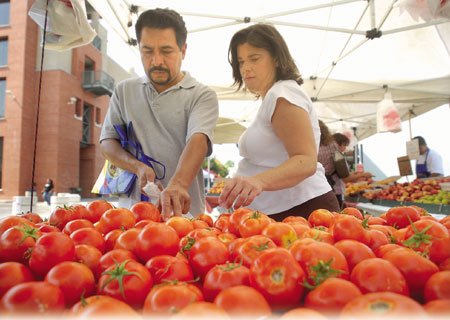Consumers are opening up to higher food prices in at least one
market
– the farmers’ market.
Consumers are opening up to higher food prices in at least one market – the farmers’ market.
Farmers market prices are generally higher than at the supermarket. But as supermarket prices jumped with the cost of gasoline in recent months, the farmers market prices stayed about the same.
Borello Farms manager Rachel Wise said she thinks it’s the higher produce prices elsewhere that are drawing people to the fresher foods available at the markets – now available for about the same price as conventional grocery stores.
“If they’re going to pay top dollar for something, I think they prefer it to be fresh and healthy,” Wise said. “People are looking to go and buy fruit that tastes good.”
And as food prices soar, consumers are getting pickier about their produce, said farmers market insiders. That, along with recent food scares and a rise in eco-mindedness, is driving more consumers to South County’s farmers markets.
California Farmers’ Market Association Director Gail Hayden said there’s been a spike in attendance this summer, with about 20 percent more people attending the regional association member markets this year than last. On Saturday, July 12, the Morgan Hill Farmers Market welcomed 1,200 shoppers. Last year, the market averaged about 1,000, she said.
The recent food scares splashing the headlines – salmonella in tomatoes, E. coli in spinach – has led to an increased awareness in food origins, Hayden said.
It’s taken a long time for this shift in consciousness, said Hayden. Paying higher prices for quality produce might be new to some customers, she added, but it shouldn’t be.
“Everyone’s conditioned to think that food’s supposed to be cheap,” she said. “People complain about paying $1 for three ears of corn instead of four, but they’re holding a $3 mocha in their hand,” she said. “Farmers were hesitant to raise the prices this year, but really, food prices had not gone up for a long time.”
Most market patrons, though, don’t care about prices. Farmers market shoppers come in two varieties, those looking for the freshest, best-tasting produce around and the idealistic types looking to support local farmers and do good by the environment.
Maria Hadsell, who browsed a recent Morgan Hill Farmers Market, is of the latter.
“I love the whole environment,” she said. “There’s pride in growing your own food. I come to show my appreciation for what the Earth can do.”
Hadsell said she respects the farmers, and likes the low-tech aspect of it.
“It brings you back to the roots,” she said.
Hollister resident Mike Patrick, choosing from an array of fruit at the Hollister Farmers Market Wednesday, said he makes the weekly visit because he believes the food is fresher, and that he’s not concerned about the price.
“I go to support the local growers,” he said.
Gwen Leonard of Hollister said she goes to support local growers as well. Leonard, who also said price wasn’t a factor for her, on Wednesday chose from Jerry Summers’ vegetable stand selling Aromas-grown produce.
“It’s local, and we should eat local food once in a while,” said Leonard.
The average heirloom tomato or yellow peach travels 41.6 miles from the fields in places like Stockton, Modesto and Romas to the Morgan Hill market, compared to the average 1,200 miles a commercial product travels, said Hayden.
“People are saving a tremendous amount by buying at their local farms, in terms of emissions,” she said.
Still, despite the increased interest in local foods, the economy has hit people hard and Gilroy farmer Ralph Santos, of Ralph’s Cherry Hut, said one way people are cutting costs is by visiting his stands less frequently.
“Cherries aren’t a staple of life, and that’s the main commodity we sell,” he said.
Santos said he was down between 10 and 20 percent from last years’ profits from the two stands he operates off U.S. 101. Making up less than 10 percent of Santos’s business, the huts are mostly repeat business, people stopping by on their way to or from San Francisco or Monterey, he said.
“Maybe we’re getting the same customers as years past, but they’re stopping once this season instead of twice,” he said. While the lower turnout isn’t affecting his business much, he said it’s not helping.
“It’s less, it’s not more, and that’s not a good thing,” he said.
Nationwide, farmers markets account for only 2 percent of produce sales volume. But the increase in the number of farmers markets has increased dramatically, more than doubling since 1994 to more than 4,300 in 2004.
“People hearing about eating food locally might not go the total locavore way, but they’ll be interested in finding out more,” said Jan Taylor, California’s Farmers Market Association manager. “And then they’ll say, ‘Hey, there’s really great food here.’ ”
And that’s what brings patrons back again and again.
The freshest, best quality fruits and vegetables a farmer has gets sent to the market. The prices are higher than at the grocery store to reflect this, said Morgan Hill Farmers Market manager Virginia Sellers.
“They like fresh goods, with ingredients they can understand and in most cases they don’t mind paying for it,” said marketeer Eda Carlson of Beckman’s Bakery.
Sabrina Arias, marketeer for Resendiz Fruit Farm in Hughson said people don’t haggle over prices much. They come for the quality; they like the way the peaches and plums at her stand are plucked that morning, she said.
Hayden said other than quality you can taste and see, there aren’t a lot of ways to squeeze sales out of a tomato – marketing tricks on produce are scarce.
“A tomato is a tomato is a tomato,” she said.
What consumers don’t think about, she said, is the poor condition of the produce they buy at cheap prices.










